See the illegal tree removals in Bayside, Boroondara, Mornington Peninsula, Whitehorse, Surf Coast
A beach box owner wanting a wider path to their ultimate status symbol, Lindsay Fox and Chris Judd are among those prosecuted — recently and in the past — for illegally changing the landscape.
Victoria
Don't miss out on the headlines from Victoria. Followed categories will be added to My News.
In front of a multimillion dollar beachfront home in the well-heeled coastal enclave of Queenscliff a towering sign has been erected, screaming “Vegetation Vandalism”.
It sits in a patch of recently cleared foreshore land at exclusive Crow’s Nest, among newly planted native seedlings — designed to take the place of the indigenous vegetation that has been ripped from the dune.
“Vegetation in this area has been illegally removed in a deliberate act of vandalism,” the massive council sign declares.
It’s not the first time the state’s smallest council, at the tip of Victoria’s Bellarine Peninsula, has used the sign-of-shame tactic to try and put an end to the illegal removal of vegetation on its fragile coastline.
There have been another three cases of tree vandalism at Crow’s Nest alone — where the luxury homes look straight across Port Phillip Bay to Point Nepean, and southwest to the Rip and Point Lonsdale lighthouse.
“With respect to this recent incident, we have not established who is responsible, so cannot confirm who the perpetrator was. No fines have been issued,” a council spokeswoman said.
“Our community is a vigilant one which reports suspicious activity to council when they see it.”
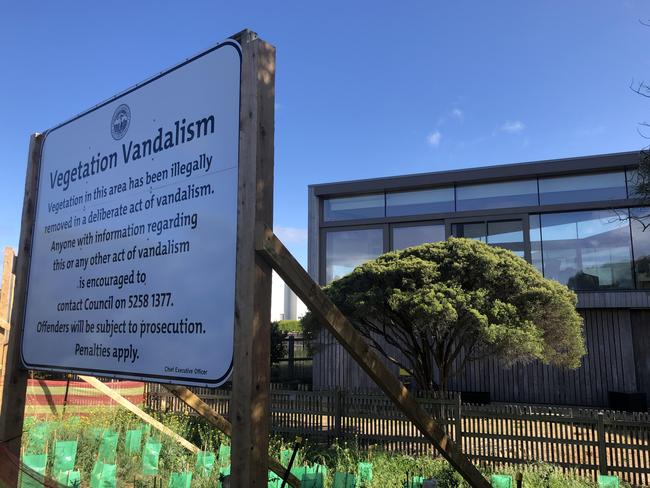
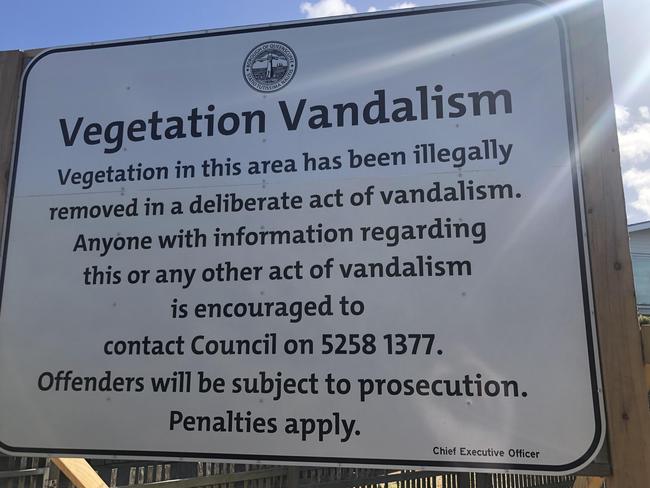
Fed up councils and communities across the state are increasingly joining suit, in seeking to shame and punish those who do the wrong thing by illegally cutting down or poisoning trees, for their own selfish interests.
Bayside City Council director of environment, recreation and infrastructure, Jill Colson, said she was aware of four instances of vandalism along Bayside’s foreshore over the past 12 months.
“Council installs tree vandalism signs to protect our precious foreshore from future acts of vandalism,” she said.
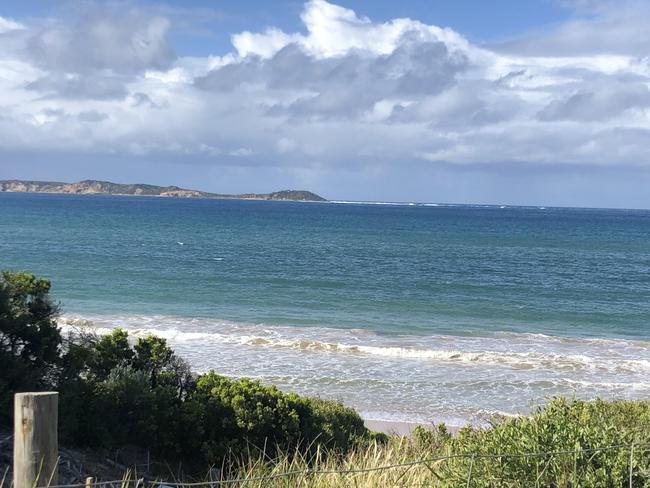
On the Mornington Peninsula — where the companies of trucking tycoon Lindsay Fox and AFL legend Chris Judd have previously been fined for illegally clearing land — a shocking 152 complaints of illegal tree removal have been investigated in the past year.
But mayor Steve Holland said the cases were often difficult to prove and prosecute through the courts without eyewitness accounts.
“Vegetation is a key part of what makes the Mornington Peninsula such a special place and I urge anyone with information about illegal vegetation removal to contact us so we can investigate and take the appropriate action. Erecting shame signs is not something we have done in recent years,” he said.
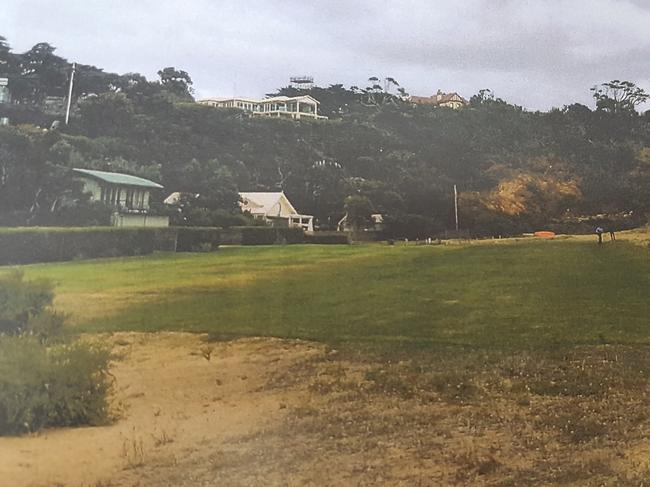
Billionaire Fox’s company was fined $20,000 in 2019 for illegally ripping up beachside vegetation and replacing it with a massive lawn, while Chris Judd’s company Three Zebras was fined $40,000 in the same year for illegally clearing 3000sq m of preserved vegetation alongside a protected creek and dam in a Green Wedge zone at his Arthurs Seat holiday home.
In August this year, the Mornington Peninsula Shire successfully prosecuted the owner of a Rosebud beach box for illegally clearing vegetation around the sand dune structure, to widen a path.
The owner, who had also constructed a deck at the beach box without planning permission, was fined a whopping $10,000.
Meanwhile in Victoria’s booming Surf Coast Shire — where council officers have investigated more than 100 reports of vegetation removal over the last five years — shaming signs have not yet been used, but some incidents have been reported to police and public notices placed in newspapers, seeking information on the culprits.
“An illegal tree removal in north Torquay and another in Rice Nature Reserve, Mount Duneed are respective examples,” the council’s general manager of environment, Chris Pike, said. Council officers could also investigate and initiate actions such as VCAT orders or penalty notices, he said.
“We previously installed steel screens with cut-outs as a visual barrier to discourage illegal tree removal to gain views, but due to negative feedback from surrounding neighbours, we abandoned this approach,” Mr Pike said.

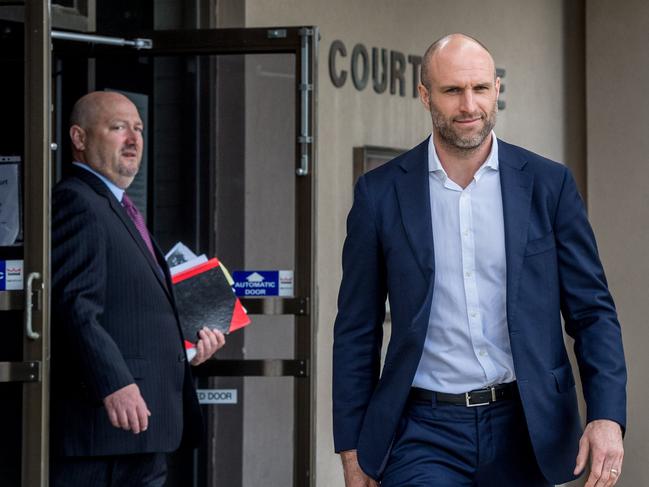
Bass Coast Shire Council said it had put signage at Cape Woolamai, but said the placement was “in no way intended to confer blame on any specific individual or property owner”.
“On the contrary, Council only resorts to erecting a sign where there is clear evidence of substantial and/or ongoing vandalism but insufficient evidence to identify and prosecute a perpetrator,” a spokeswoman said.
“Signs are erected as a deterrent and positioned such that they interrupt the maximum number of view lines to properties that stand to ‘benefit’ from the vandalism.”
But illegal tree removal is not only a problem in coastal areas, where premium views bring premium sale prices.
In leafy Melbourne areas, a penchant for pools, decks and other creature comforts — that trees can stand in the way of — sees scores illegally cut down each year.
The City of Boroondara recently flagged it was considering publishing “name and shame” registers — via a list of public prosecutions on its website — to deter residents and developers from illegally chopping down trees in the municipality.
The council has issued an average of 50 infringements each year, for the last five years, and prosecuted 20 companies and individuals.
Boroondara council director of urban living, Scott Walker, said trees were “an integral component of the character, heritage and landscape of Boroondara”, and “illegal removal of protected trees is a blight on our community and environment”.
The council responded to more than 200 potential illegal tree removals on private properties each year, he said.
“Every single matter is investigated by council and enforcement actions such as infringements, warnings, prosecutions, and replacement tree planting are taken where appropriate.
“Council does not install ‘shame signage’ but aims to educate Boroondara residents on the importance of trees and other vegetation to the Boroondara landscape. A significant tree register is published on our website, along with information on planning permits and local laws,” Mr Walker said.
The City of Whitehorse, which includes the suburbs of Blackburn, Box Hill and parts of Balwyn North, has also not ruled out a public shame register.
A Whitehorse City Council spokesperson said it had received more than 400 tree removal requests in 2023, with a range of between 660-880 requests per year over the past three years. These included residents seeking information about tree removal permits and exemptions, she said.
“This year, we have received around 150 alleged breaches of the planning scheme related to tree removal. These complaints have required officer investigation into removal or damage of trees. Over the past three years, this has varied between 150 and 290 cases where removal or damage of trees has been investigated,” she said.
“Over the past 3 years there have been about 70 infringements and 15 Magistrates Court proceedings, some of which have resulted in larger fines and others resulting in stringent tree replacement requirements, and legal agreements being placed on the land to implement replanting and ongoing management.”
The law on native tree removal
In Victoria, a permit is usually required to remove, destroy or lop native vegetation. These regulations are known as the native vegetation removal regulations and are primarily implemented through local council planning schemes.
The Victorian government empowers councils to take action if and when they become aware of the illegal removal of vegetation, describing environmental harm as “any impact on the environment as a result of human activity that has the effect of degrading the environment, whether temporarily or permanently”.
When determining the significance of any illegal native vegetation removal, councils should consider the extent of the removal (how many trees have been removed) and where they have been removed from, especially if they have been taken from environmentally sensitive areas or provide habitat for rare or threatened species, the Department of Environment says.
Councils have the power to take administrative action like negotiation and providing information letters but can also issue official warnings, planning infringement notices, enforcement and interim enforcement orders, and to prosecute.




